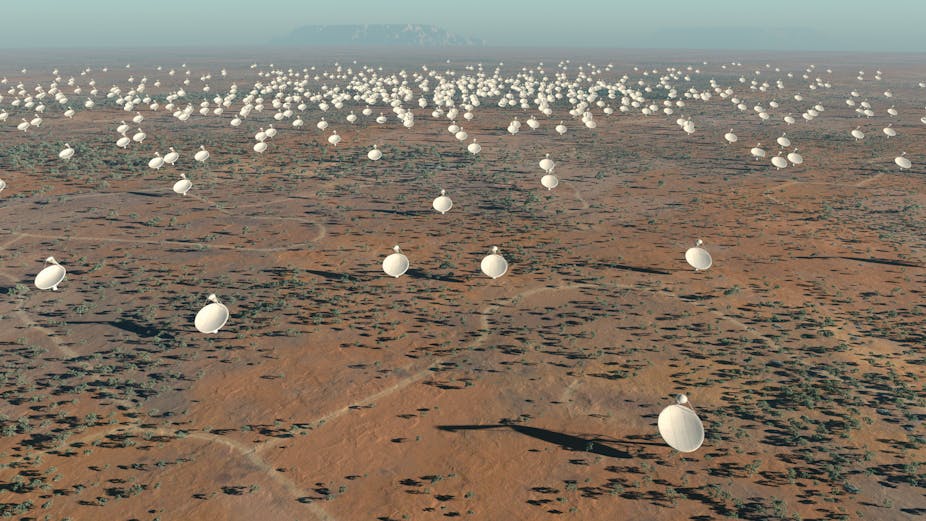Australia and New Zealand could be on the brink of a major scientific coup. In roughly a month’s time, the site for the Square Kilometre Array (SKA) radio telescope will be announced.
Australia and New Zealand are competing against a consortium of nine African countries – led by South Africa – for the right to host this A$2 billion mega-science project – one of the largest and most ambitious scientific projects ever conceived.
Last year, representatives from Australia-New Zealand prepared a detailed submission to assist the SKA Site Advisory Committee with its deliberations. I was lucky enough to be a part of that team.
The document, which exceeded 1,000 pages and included input from more than 40 organisations and agencies, provided data in sometimes eye-watering detail on the physical and environmental characteristics of our candidate site. It also described the social, political and legal structures relevant to administering the project in Australia and New Zealand.

For several weeks, submissions from both candidate sites were scrutinised by an international panel of experts. Very shortly, in the next few weeks, the committee will deliver its recommendation of the preferred site to the SKA Board of Directors. The board will then have the final responsibility for choosing a site. This decision is expected to be announced in mid- to late-March.
The level of anticipation within the scientific community is palpable. Astronomers, engineers and officials are collectively holding their breath, awaiting the announcement.
I have witnessed a remarkable level of enthusiasm from the general public. At an ABC “meet a scientist” event last year I asked a young girl – of around 11 years old – if she knew what a radio telescope was. Her reply stunned me: “Is that like the SKA?”, she asked, before proceeding to tell me there was competition between Australia and South Africa to host the telescope.
So what makes the ideal site for the world’s most sensitive radio telescope?
The primary consideration is, unsurprisingly, the suitability of the location for radio astronomy. With the rapid expansion of electronic communications devices such as mobile phones, radio astronomers around the world have experienced a large negative impact from the encroachment of stray “radio frequency interference” into their telescope receiver systems.

This can be extremely damaging to science output and costly to mitigate. CSIRO’s existing observatories in rural New South Wales – such as the Parkes Observatory – are increasingly suffering from population growth and the associated radio interference. The problem will be much more acute for the SKA, which will be more sensitive and observe over a very large frequency range, in order to pick up signals from the distant universe.
To avoid such man-made interference, CSIRO, working with WA State and Federal Governments, has established the Murchison Radio-Astronomy Observatory in one of the most remote areas of Western Australia.
By way of contrast, the region within 100km of CSIRO’s Paul Wild Observatory near Narrabri, NSW, has a population density of one person per square kilometre. Within 100km of our candidate SKA site, the figure is 100 times lower.
In order to protect this extraordinarily radio-quiet region, CSIRO and government agencies have negotiated a strong legal framework to protect the Murchison Radio-Astronomy Observatory for generations to come.

The SKA will comprise a number of different receiver systems, which will enable observations over a large frequency range. There are strong scientific advantages of placing these systems at a single, high-quality site:
- the infrastructure cost is shared between the high- and low-frequency receivers, increasing the available budget for the (scientifically productive) hardware and active components of the telescope
- the scientific return of a geographically distributed telescope is diminished because simultaneous observations of the sky over a large frequency range would be impossible
- if man-made interference were greater at one location, it would inevitably diminish the science return to place any antennas on the site more afflicted by radio interference.
For these reasons, I have no doubt that the merit-based process to identify a single site for the telescope is the correct approach. Given the SKA will inhabit one of the last remaining radio-quiet sites on Earth, the quality of science is not an area in which we can afford to compromise.
I have heard the SKA site bid compared to an Olympic bid, but in many ways that understates the significance of the project. A successful SKA telescope will provide a massive boost for science worldwide, together with the spin-off benefits that flow from such internationally focused innovative technology projects.
This will happen, provided the very best site is chosen to enable maximum potential for scientific discovery and maximum engagement from the global technology community.
Australia and New Zealand have incredibly strong credentials to support the SKA on behalf of the whole world for the 50-year lifetime of the instrument. I hope in 2012 – an Olympic year – we ensure scientific excellence emerges from this process victorious.

